Becky Shindell PPC Do's and Don'ts #semrushchat 84 Wow-Score The Wow-Score shows how engaging a blog post is. It is calculated based on the correlation between users’ active reading time, their scrolling speed and the article’s length. Learn more PPC Do's and Don'ts #semrushchat
- 163
- 24
- 22
- 2
Running a Pay-Per-Click (PPC) campaign can be one of the fastest and most effective ways to drive quality and highly targeted traffic to your website and landing page. When done right, PPC can deliver immediate results, helping your business get to the top of the SERPs. When done wrong, you run the risk of pouring your money down the drain.
We decided to get the essential PPC do’s and don’ts that help marketers to get the most out of their advertising campaigns. Brad Geddes, the co-founder of Adalysis, author, speaker, and PPC professional, along with our other SEMrush Chat guests shared their experience and views on how to make sure that you spend your budget as effectively and efficiently as possible:
Q1. What do the top 1% of PPC specialists do that the other 99% do not?
Balancing between crafting a compelling copy and strategically defining your target audience can be challenging. If you want to become a PPC pro, here are some tips:
![]()
Specials thanks to everyone whose tweets we used to make this image: @bgtheory, @revaminkoff, @AccuraCast, @RamkiJeyam, @i_praveensharma, @Digital_JB, @simoncox
Make sure to keep these things in mind the next time you plan your PPC campaign!
Q2. Should PPC campaigns have different landing pages or the same one? What is the best strategy and why?
A poorly managed PPC campaign can cost more than it brings in, but a strategically managed campaign can help your business to thrive. In order to get the most out of your AdWords campaign, do you need to create different landing pages for your PPC campaigns?
As Brad Geddes – @bgtheory explained, each ad group should be a unique idea, and each idea needs to have its own dedicated landing page.
A2. Each ad group should be an 'idea'. Each idea should be a landing page. Rarely will one page work for multiple ideas. #SEMRushChat
— Brad Geddes (@bgtheory) September 13, 2017
Not everyone has the time and the resources to craft a dedicated landing page for each ad group. Whether or not you want to create different landing pages or have the same one for different PPC campaigns depends on various factors, such as your advertising budget, niche, and/or your goals.
A2: Depends on the situation and budget… there is no "clear" answer, though generally you want to split test and hyperfocus #semrushchat
— Jake Bohall (@jakebohall) September 13, 2017
A2: depends in industry. Landing pages are so crucial to getting customers in the pipeline. They can have different objectives #semrushchat
— April Twenty Five (@apriltwentyfive) September 13, 2017
Start with one landing page per campaign, and if you have the time and resources to build a new page, you can add it in:
A2: Best strategy is to work within the budget to determine landing page efficacy. Test, test, test to see which is best!#semrushchat
— ThinkSEM (@ThinkSEM) September 13, 2017
In a perfect world, each of your PPC campaigns would have a specific goal. In order to maximize your return on your ad investment, you should craft a landing page that is dedicated to that objective. In order to improve your conversion rates, you should customize your pages to match your campaign goals. To achieve this, you can create different landing pages for each of your ad groups and keywords.
A2. Specificity is key in digital ads. You can't be specific with one generic landing page. If budget allows, ad-level LPs work #semrushchat
— Doug R. Thomas, Esq. (@ferkungamaboobo) September 13, 2017
If you want to get the most out of your campaigns, make sure to test elements, such as your landing pages. Ideally, you should create an individual one for each of your AdWords campaigns.
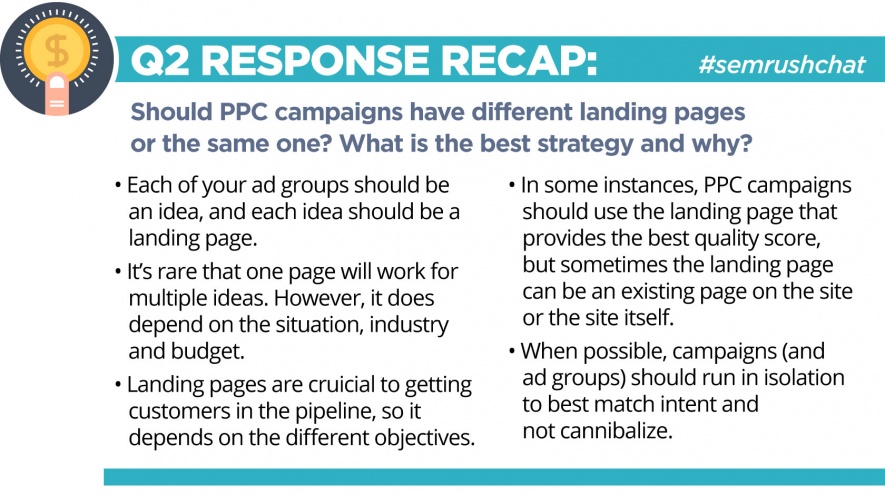
Q3. Is it best to use "Bid Only" or "Bid and Target" for RLSA? Why is one better than another?
Remarketing lists for search ads (RLSA) enables advertisers to tailor their bids and customize their search ad campaigns based on whether a user has previously visited their website and the pages that they viewed. There are two targeting settings that you can choose between, depending on whether or not you want to show your ads to users who are only on your remarketing list or to all:
-
Display your ads to all users searching on Google. Set a bid adjustment for your audiences and adjust the Interests and Remarketing settings to “Bid Only.”
-
Show your ads only to people who are on your remarketing list and searching on Google. Set the Interests and Remarketing option to “Target and Bid.”
A3. Bid Only doesn't restrict ads to showing for the targeting method that have been selected. This is the option I mostly use. #semrushchat
— Fanny Heuck (@FannyHeuck) September 13, 2017
A3: I prefer Bid and Target, since i know where my buyer persona are mostly active and control where my ads appear. #semrushchat
— Ramakrishnan🚀 (@RamkiJeyam) September 13, 2017
Each of these options has pros and cons. The benefits of the “Target and Bid” setting is that it is restricted to a certain audience and enables you to advertise more specifically to this audience. For example, you can instruct the system to target particular keywords, topics, websites, and more.
On the other hand, the “Bid Only” option provides a broader approach and doesn’t restrict your ads to only show the targeting method you’ve selected. This setting allows you to set your bids for individual targeting.
A3. They aren't better or worse; they are different & you can use them both in the same campaign with different ad groups. #SEMRushChat
— Brad Geddes (@bgtheory) September 13, 2017
You can also try some advanced targeting combinations, depending on your specific goals. For example, if you want to reach as many users as possible, there is no need to add too many targeting options to your ad group. However, you can add several targeting methods to set bids on a particular one without seriously limiting your reach.
A3: A mixed strategy using both bid only AND target and bid will likely be best, but you'll only find out through testing. #semrushchat
— Zack Bedingfield (@zackbedingfield) September 13, 2017
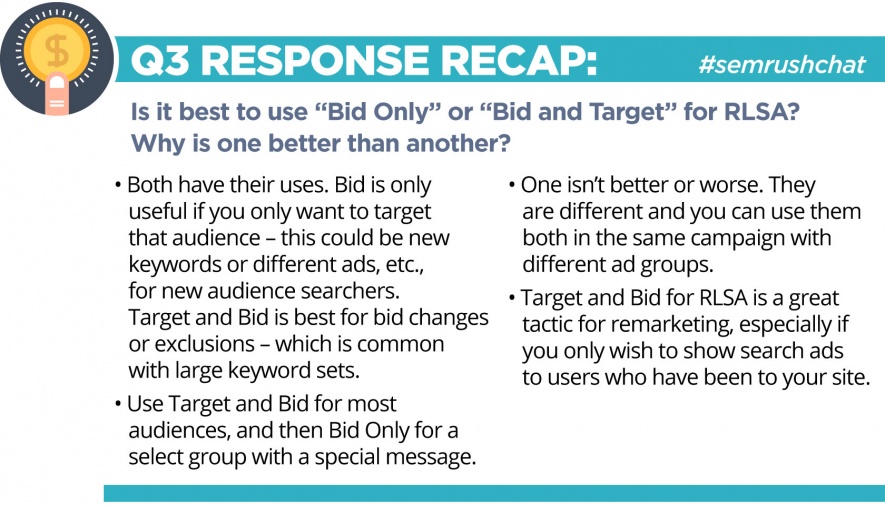
What are your thoughts on these targeting options for RLSA? Make sure to share them in the comments; we would love to hear your opinion!
Q4. When it comes to A/B Testing, what is the best way to present a proposed PPC ad copy to clients for their approval?
Let's say you need to present a proposed PPC ad copy to your clients for their approval for A/B testing. As a PPC expert, how can you do it in a client-friendly way? These tools may help:
Google AdWords Editor. This is a free application that helps manage large AdWords accounts and advertising campaigns. You can download more than one account, easily make changes online, and then upload these changes to AdWords. It is especially useful for accounts with several campaigns and lists of keywords and ads. Editor enables you to view, edit, and manage multiple accounts at the same time. The tool also allows you to export and import files to share proposals.
A4: There are a million different ways: we prefer to export the account from Editor for a clean, intuitive look.#semrushchat https://t.co/Y7WlxSL8tR
— ThinkSEM (@ThinkSEM) September 13, 2017
Ad Preview Tool for Google AdWords. This service is designed to help advertisers envision Google AdWords ad headlines, with the latest character limits and layout set by Google. With this, you can try and see which ads and ad extensions are appearing for your keyword. This is very helpful if you want to check out how your ad appears in search results, without affecting your performance statistics by collecting ad impressions every time you search for your ads. However, the tool requires your ads to be uploaded to AdWords. You can also try out SEMrush's Ads Builder, located in the projects section.
A4. Use Google's Ad Preview Tool, That's the best way to show the customer the ads exactly as they would appear and in context. #semrushchat
— NinjaCommerce (@ninjacommerce) September 13, 2017
A4. If we're talking a small number of A/B tests, then screenshots from the Ad Preview Tool are best to show clients #semrushchat
— AccuraCast (@AccuraCast) September 13, 2017
Google Sheets. Loved by many marketers, this free and easy-to-use service is a great way to create and edit complex spreadsheets.
A4: I love Google Sheets for presenting A/B testing ads to a client. You can potentially collaborate for revisions. #SEMrushchat
— Danny Ray Lima (@dannyraylima) September 13, 2017
Brad Geddes – @bgtheory provided his own spreadsheet template with columns that you may also want to include in your proposal:
A4. I like a spreadsheet with these columns: #SEMRushChat pic.twitter.com/q9AC7Nrhdq
— Brad Geddes (@bgtheory) September 13, 2017
On the other hand, Craig Campbell – @craigcampbell03 believes that your clients should be involved in all processes of planning a successful PPC ad campaign since they know their business and market and you can use their knowledge.
A4. Dont present, get their input, work with them on it, they know their business so id have them as part of the process too. #semrushchat
— Craig Campbell (@craigcampbell03) September 13, 2017
Keep your proposal simple to ensure that your clients understand all of the data you provide and make sure to communicate and collaborate with them.
Q5. How can someone ensure that their PPC ads focus around the specific needs of their potential consumers/customers/viewers?
Despite the formatting changes in ad layouts that Google continues to test, its ad requirements have stayed constant over time. Your ad should be focused on your customers’ needs. Here are the four essential steps to do it right:
1. Utilize Google AdWords Keyword Planner
This provides marketers with data that they need to make informed decisions. The Keyword Planner takes groups of keywords and mixes them to provide hundreds of combinations. It helps you to identify almost every possible combination that people use to search for your brand or your products, especially if you are eCommerce.
A5. Google's Keyword Planner Tool is a great place to start. A Little commonsense and tracking of user behaviour. #semrushchat
— NinjaCommerce (@ninjacommerce) September 13, 2017
2. Conduct a Thorough Research
To better understand your potential customers and identify what problems they want to solve, you need to do thorough research. There are multiple ways to learn about your target audience:
-
Find out what they search for by using things like Google’s Autocomplete and the “People also ask” feature.
-
Look into communities like Quora and Reddit.
-
Listen to social conversations.
-
Conduct quantitative surveys.
-
Learn from what your competitors and other marketers have found (e.g., case studies and psychological analyses).
These tactics will help you to better understand your target audience and track their behaviors.
A5. Research what ur audience searches for, look into communities like quora, reditt,etc. Hv keywords as per their intent. #semrushchat
— Praveen Sharma (@i_praveensharma) September 13, 2017
A5 Good research and focus groups before campaign then Analyse results and test to death during it.#SEMRushChat
— Simon Cox (@simoncox) September 13, 2017
3. Address Your Audience’s Pain Points
Once you have done your research, you can start working on your PPC campaign(s). Based on your findings, you can shape everything you create, i.e., an ad headline, a description line, a call to action, etc. for your target audience.
A5. Address pain points. Consider why need. Write good/bad emotional thoughts. Write down logical answers. Mix & match w/ tests #SEMRushChat
— Brad Geddes (@bgtheory) September 13, 2017
A5: Match perceived intent as closely as possible. Test conversion funnels like a prospect would. #SEM #PPC #semrushchat
— Jason Barbato (@Digital_JB) September 13, 2017
4. Avoid Tricking Your Audience
Some marketers make the mistake of bidding on the wrong terms on purpose, and this approach can lead your audience in the wrong direction. It is important to create a balance between getting creative with your ads and being careful to not mislead your customers with your main ad message.
A5: Don't mislead people! Create ad copy and landing pages that accurately represent your product or service offering #semrushchat
— Tim Levene (@timlev4) September 13, 2017
In order to learn how to bring more visitors to your site, you can also check out the SEMrush Checklist for Running a Successful PPC Campaign.
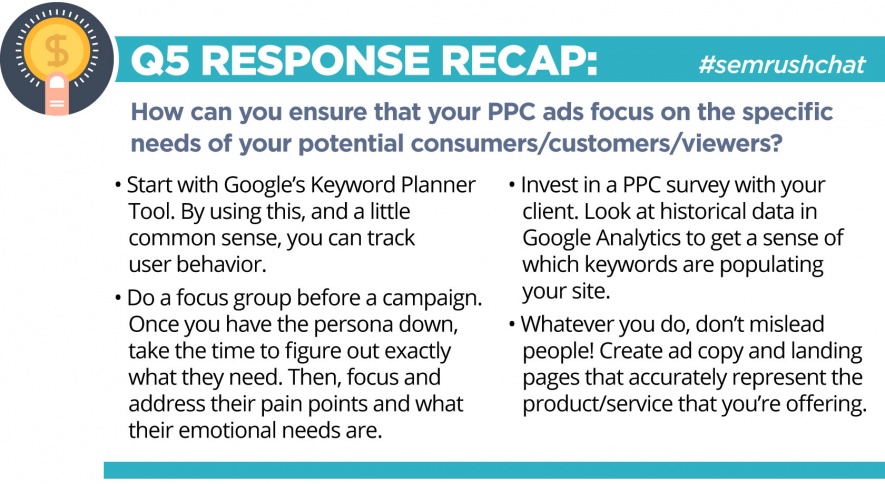
None of the described methods will give you a perfect picture of your potential customers and show you their wants accurately and fairly. However, what you definitely can do is to collect your findings from multiple sources and analyze them to create a more comprehensive vision. It will help you significantly improve your advertising campaigns.
Q6. If your PPC Strategy isn’t working at all, in which case would you reevaluate and alter your strategy?
When it comes to running a successful PPC campaign, you can't just set it and forget it. You can’t allow Google to automate everything, instead, you need to keep track of your progress on a regular basis. However, you can still have a regularly maintained, well-guided campaign, and your strategy may not deliver the desired results. In that case, you may want to revise your strategy.
Experiencing low click-through-rates is the first sign that you need to reevaluate your PPC efforts. If you are at risk of a low CTR, Google may interpret your ads as being less relevant and as a result, your quality score, which is a variable used by search engines that can influence your rank and CPC, will suffer.
A6. If you just aren't getting clicks, that's a big reason to revaluate your PPC strategy – usually the case with new concepts #semrushchat
— AccuraCast (@AccuraCast) September 13, 2017
If your PPC campaign doesn’t achieve its goals, you may want to revise your strategy.
A6. If goals are not reached at all after 3 months of hard work and try. Or if goals are over-reached, then boost budget #semrushchat.
— Fanny Heuck (@FannyHeuck) September 13, 2017
There may be multiple reasons why your strategy isn't working:
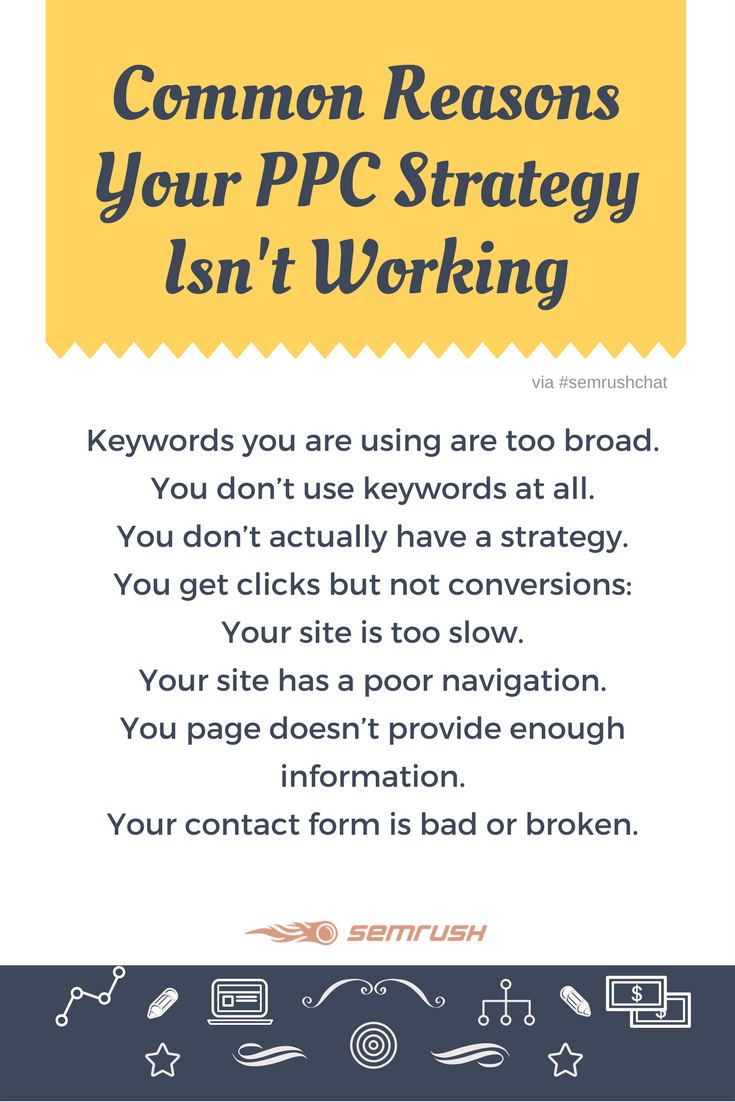
These are just some of the most common reasons why your PPC efforts don’t make any money. When you figure out what is wrong, you can optimize your strategy.
A6: Figuring out things that don't work helps you get to things that will. Document it all and look for things to try/change. #semrushchat
— Julie F Bacchini (@NeptuneMoon) September 13, 2017
Our chat participants pointed out that it is worth reevaluating your advertising campaign on a regular basis whether you are doing well or not so that you can make changes and improve it.
A6. Always. Be. Testing. Constantly reevaluate and look at things from another angle, you never know how good things could be #semrushchat
— NinjaCommerce (@ninjacommerce) September 13, 2017
A6. I think you should evaluate your strategy *at least* every quarter regardless if you are doing well or not. #SEMRushChat
— Brad Geddes (@bgtheory) September 13, 2017
PPC ads represent a great opportunity for your business. You just need to understand what is working for your market and your target audience and make sure you don’t fall victim to the common mistakes that some marketers make.
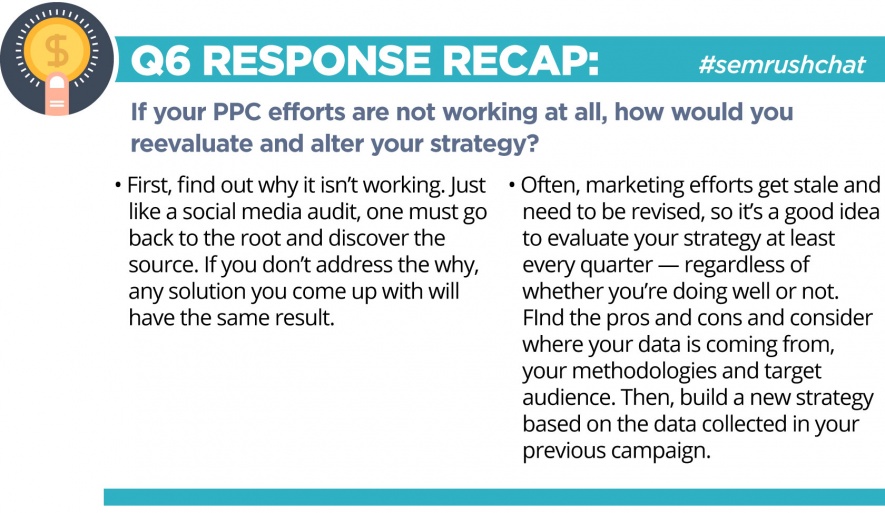
As you can see, the success of your PPC campaigns relies on doing the right things, monitoring your progress, and testing.
Huge thanks to Brad Geddes and our other chat guests for providing these PPC do’s and don’ts! Hopefully, their tips will help you towards your PPC advertising success.
Join us this Wednesday as we discuss how search and social are better together with Jaydip Parikh!
PPC  Becky Shindell Becky Shindell is the US Social Media Manager at SEMrush and host of the weekly #SEMrushchat. Connect with her on LinkedIn and follow her on Twitter. You can find Becky at many of the US Digital Marketing Conferences, feel free to say hi!Read the original article here
Becky Shindell Becky Shindell is the US Social Media Manager at SEMrush and host of the weekly #SEMrushchat. Connect with her on LinkedIn and follow her on Twitter. You can find Becky at many of the US Digital Marketing Conferences, feel free to say hi!Read the original article here



